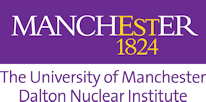
The New Nuclear Manufacturing programme
The New Nuclear Manufacturing (NNUMAN) programme undertook long-term research into innovative manufacturing techniques for the future needs of the UK nuclear industry.
The background
The NNUMAN Community
The ongoing NNUMAN Community, a legacy of this programme, promotes networking for nuclear manufacturing research and development and welcomes those from industry, academia and HVM Catapult seeking opportunities for collaboration, cross-disciplinary development, research proposal development and information exchange.
For more information contact:
The programme, managed by the Dalton Nuclear Institute at The University of Manchester and supported by the Nuclear AMRC at The University of Sheffield, was largely funded by the Engineering and Physical Sciences Research Council with further financial and in-kind support coming from the two universities and industry.
NNUMAN addressed the fundamentals of advanced manufacturing for new reactors and the next generation of nuclear power stations driving progress towards new, high productivity nuclear manufacturing technologies and their transition from the laboratory to production-readiness.
The programme involved a high level of academic and technical support and provided a training opportunity for a number of postdoctoral and PhD researchers to join the next generation of nuclear manufacturing scientists and engineers.
The challenge
The strict quality standards and slow product cycle of the nuclear industry have historically limited the uptake of many innovative welding and joining technologies. Future designs for large nuclear vessels and components require more efficient manufacturing and machining techniques for both existing and future reactor materials.
The solution
NNUMAN undertook long-term research into innovative manufacturing techniques for the future needs of the UK nuclear industry. It addressed the fundamentals of advanced manufacturing for new reactors and the next generation of nuclear power stations:
- Innovative joining technologies - Investigated techniques including narrow groove arc welding, electron beam and laser welding of reactor steels.
- Advanced machining and surfacing - Explored highly innovative approaches for machining very large components, for example using deep-hole drilling and using machining robots with indoor positioning systems, together with assisted machining techniques.
- Near-net shape and engineered structures - Concentrated on developing a detailed understanding of the correlation between powder properties, manufacturing process and finished material properties.
- Advanced Nuclear Fuel - Addressed a number of issues in both of these areas as part of a broader portfolio of research within the UK’s Nuclear Fuel Centre of Excellence.
- Underpinning materials research - Performed studies and tests which underpinned all other parts of the NNUMAN programme.
The benefits
By acting as the research engine for nuclear manufacturing, NNUMAN drove progress and step-change technologies up the Technology Readiness Scale.
The most promising manufacturing processes developed in NNUMAN are being taken forward to prototype in the Nuclear AMRC and the National Nuclear Laboratory (NNL) so that UK manufacturing companies can learn the benefits of the new methods and use them in the future.
Impact includes:
- Innovative joining technologies - The comparison of different narrow groove welding processes, including measurements of distortion, residual stress and microstructural properties across the weld region will inform choices in the fabrication of major nuclear components of the future.
- Advanced machining and surfacing - Produced a coherent linkage between machining parameters and surface conditions for a range of nuclear materials, providing a means of optimising machining productivity for particular applications.
- Near-net shape - Work on linking powder oxygen content to the spatial density of non-metallic inclusions in the metal product and then to fracture properties provided powder manufacturers with key evidence in setting lower powder oxygen levels.
- Advanced Nuclear Fuel - Identified a ceramic braze composition for joining Silicon Carbide composite fuel cladding to provide significant additional margin for fuel integrity under accident conditions.
